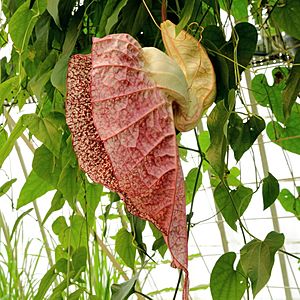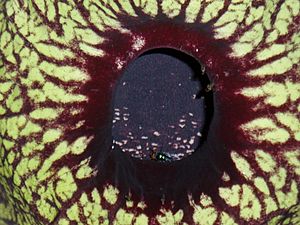Pelican flower facts for kids
Quick facts for kids Pelican flower |
|
|---|---|
 |
|
| Scientific classification | |
| Genus: |
Aristolochia
|
| Species: |
grandiflora
|
The pelican flower, also known as Aristolochia grandiflora, is a special type of vine that loses its leaves every year. It has some of the biggest flowers in the world! These amazing flowers give off a strong smell, a bit like stinky socks or rotting meat. This smell helps them attract flies, which are important for the plant to make seeds.
Contents
What Does the Pelican Flower Look Like?
The pelican flower grows large, single flowers from where its leaves meet the stem. Its leaves can be as wide as 25 cm (9.8 in), which is about the length of a ruler!
The flowers themselves are shaped like a heart. They can be 10–20 cm (3.9–7.9 in) wide and have long "tails" that can reach up to 60 cm (24 in) long. That's like two rulers put together! The flowers are usually green and white with purple or brown lines. The middle part of the flower is darker. This dark color, along with its unique smell, helps to attract insects that spread pollen.
Each pelican flower has three main parts: the utricle, the tube, and the limb. These parts are common in all plants from the Aristolochiaceae family.
Where Does the Pelican Flower Grow?
This interesting plant naturally grows in the warm, sunny areas of the Caribbean and Central America. It has also been brought to Florida in the United States. People planted it there because it helps attract beautiful butterflies. You can often find pelican flowers growing in tropical forests, especially near streams and small valleys.
How Does the Pelican Flower Reproduce?
The pelican flower has a clever way of making new plants. It uses flies to help with pollination. The flower makes a special smell, which is a mix of different essential oils. This smell attracts flies that are looking for a place to lay their eggs.
When a fly lands on the flower, it crawls down a tube-like part into a chamber called the utricle. This chamber is where the plant's reproductive parts are. The tube has tiny hairs inside called trichomes. These hairs act like a one-way gate, guiding the fly deeper into the flower and stopping it from leaving right away.
The reproduction process happens in three steps:
- Step 1: Pollination If the fly already has pollen from another pelican flower on its body, it will drop that pollen onto the flower's female part, called the carpel. This is how the flower gets pollinated.
- Step 2: Releasing New Pollen After the flower is pollinated, the male parts of the flower, called the stamen, become ready. They release new pollen onto the fly. This step usually lasts for about one day. While the fly is trapped inside, it can eat sweet nectar that the flower produces. After a while, the tiny hairs inside the tube wilt and fall away. This allows the fly to escape, now carrying new pollen to another flower.
- Step 3: Flower Fades The whole process takes about two days. After that, the flower starts to wilt and eventually falls off the plant.
What Is the Pelican Flower Used For?
People use the pelican flower for a few different things:
- Decoration: Its large, unique flowers make it a popular plant for gardens and displays.
- Food Source: For some animals, it's a food source. For example, the caterpillars of swallowtail butterflies eat the leaves of the pelican flower. When they eat this plant, they take in special chemicals called terpenes. These chemicals make the butterflies taste bad to predators, helping them stay safe!
- Traditional Medicine: In some cultures, parts of the plant have been used in traditional medicines.
Important Information About the Pelican Flower
It's important to know that the pelican flower contains a chemical called aristolochic acid. This chemical can be harmful and is considered a carcinogen, which means it can cause cancer. Because of this, many products containing this chemical have been banned by health organizations, like the USDA in the United States.
The plant also has other chemicals called alkaloids. These chemicals help the plant protect itself from insects and tiny plant germs. The plant's essential oils contain many different chemicals, too, like α-phellandrene and linalool from its stems and roots, and germacrene D from its leaves.
Other Pelican Flowers
The name "pelican flower" is also used for other types of Aristolochia plants. For example, Aristolochia gigantea is known as the "giant pelican flower," and Aristolochia nana is called the "tiny pelican flower."
See also
 In Spanish: Aristolochia grandiflora para niños
In Spanish: Aristolochia grandiflora para niños


